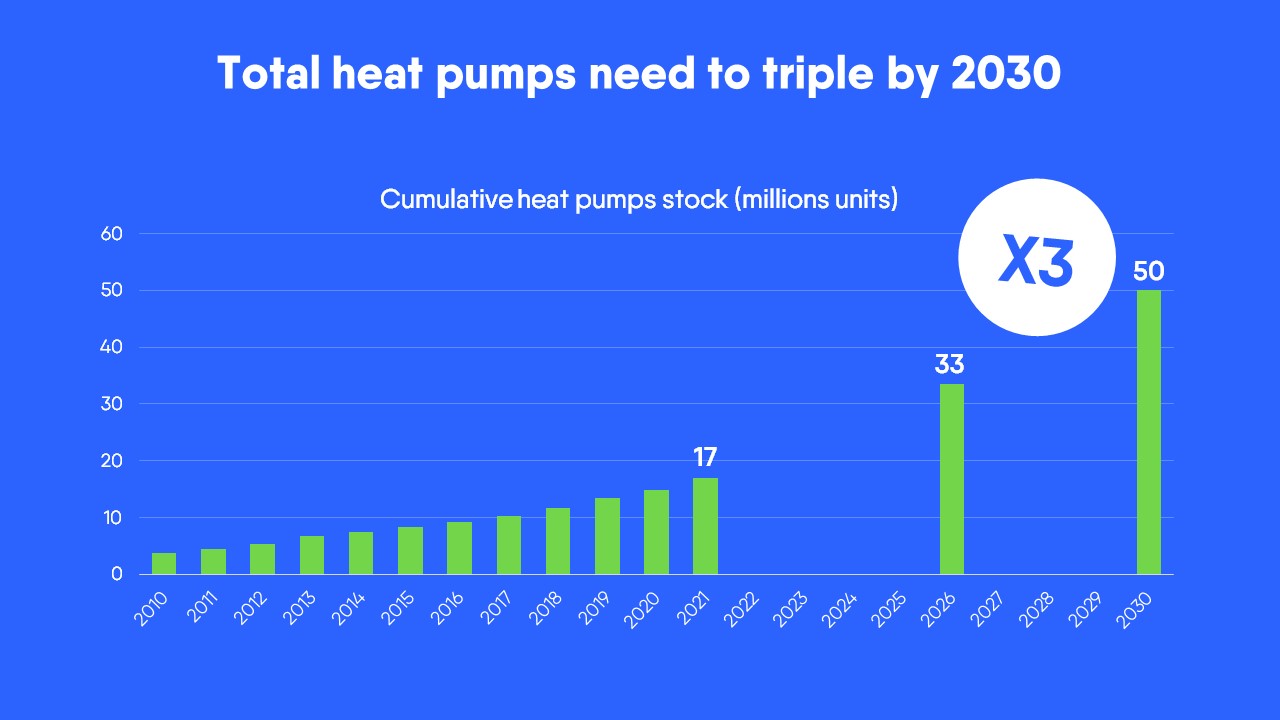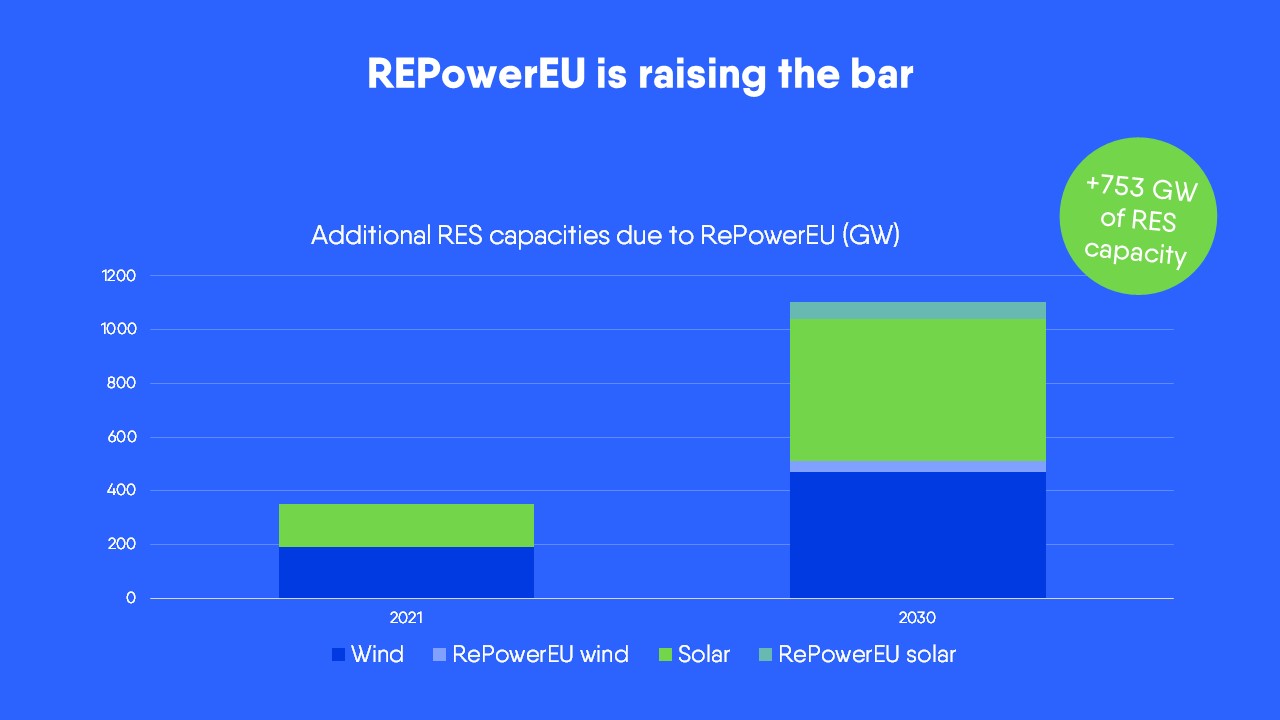Electricity industry leads the way to a net zero emissions economy

The European electricity industry accelerates its decarbonisation process actively supporting the international climate action efforts and Europe’s ambition of a net zero emission economy by 2050. Eurelectric’s Power Barometer, an analysis of industry-wide trends in the EU power sector, reveals several proofs of rapid decarbonisation. Ongoing developments with energy prices and inflation, Russia’s invasion of Ukraine, security of supply concerns further reinforce the urgency of a net zero economy. The cruel awakening is there: Europe remains much too dependent on imported fossil fuels and needs a structural shift to clean electricity as a way to regain its energy independence.
Leveraging a data-driven approach and the latest information available, the Power Barometer, reflects a historic development in the power sector: clean and renewable energies incrementally dominate the electricity mix, while fossil fuels continue to lose ground. This has led to a significant reduction in electricity’s carbon emissions and is now offering a cost-effective solution for decarbonising transport, heating and cooling and other industrial applications.
Net zero emissions: what, why and how?
The International Panel on Climate Change (IPCC) considers that net zero carbon dioxide (CO2) emissions, also referred to as carbon-neutrality, represents the balance between anthropogenic carbon emissions and their removal from the atmosphere over a specified period of time. In other words, offsetting the emissions produced by human activity.
Decarbonisation is the main avenue for removing or reducing the carbon dioxide output of a country’s economic activities. CO2 is mainly produced by burning fossil fuels and is the most prevalent greenhouse gas (GHG), which has been proven to significantly contribute to global warming when released into the atmosphere.
In the 2015 Paris Agreement, 195 countries members of the UN set a target of keeping the global temperature rise to well below 2°C, and pursue efforts to limit it to 1.5°C. This means that reductions in GHG emissions, including decarbonisation measures, need to be implemented by all sectors of the economy, across the world.
Climate change is an existential threat, which requires urgent global action. The 2021 IPCC report has issued a dire, yet irrefutable, warning: greenhouse gas emissions from fossil fuel burning are causing an irreversible change to the climate. If each government takes rapid action to cut GHG emissions, such as carbon dioxide, some of these effects could be limited.
Accelerating the transition to a net zero emissions economy will not only help tackle climate change and global warming. It is also a crucial step to cut Europe's dependence on fossil fuels.
What is the difference between zero emissions and net zero emissions?
While ‘zero emissions’ means halting the release of gases into the atmosphere, ‘net zero’ refers to an overall balance between produced and offset GHGs. Getting to net zero means we can still generate emissions, but they must be accompanied by offsetting processes that reduce their presence in the atmosphere. Some examples include the natural sinks, like planting new forests, or new technologies like carbon capture.
Is net zero emissions possible?
The technology needed to accelerate towards net zero emissions is already available. Over 100 countries across the globe have already pledged to curb their carbon emissions to reach net zero by 2050 at the latest. The EU, for instance, has set a target to reduce its GHG emissions by at least 55% compared to the 1990 levels by 2030 and has further set an aspiration of a climate neutral, net zero emission economy by 2050.
What’s more, private companies and industries are ramping up their efforts to reduce their carbon footprint, some even going for a carbon negative target. Initiatives like Carbon Free Energy 24/7, which bring together technology providers, generators and end-users, enable corporate renewable energy sourcing round the clock. This means that companies that have established science-based targets (SBTI) or are seeking to move in this direction, can cover their needs with a guaranteed net-zero power flow. This contributes to tackling their scope 2 emissions, those caused indirectly by company when it purchases energy, helping achieve the Paris Agreement.
Why decarbonisation targets are a key step towards net zero emissions?
Decarbonisation is essential to guarantee long-term sustainability and avert the worst consequences of anthropogenic climate change.
Recognising the need to take climate action and transition to a low carbon world, the European power sector has committed to decarbonise the electricity mix well before mid-century. Since then, companies have taken measures to clean up the power supply and become a cost-effective solution for cutting carbon emissions from energy intensive sectors, like transport, heating and cooling and industrial processes.
Eurelectric’s landmark study, Decarbonisation Pathways, assessed multiple scenarios to deliver on the Paris commitments and has shown that Europe’s electricity can be carbon neutral by 2045, following an increase in renewable energy capacity coupled with the retirement of fossil fuelled power plants.
Since then, carbon emissions from the power sector have plummeted faster than anticipated, putting Europe’s electricity on a fast track to net zero emissions.
Europe is currently facing a difficult situation however: its energy independence is at risk, following Russia's invasion of Ukraine and its attempt to weaponise gas supplies. While policy measures are taken to ensure a rapid deployment of renewable capacities, some countries are restoring mothballed coal power plants to ensure the security of supply. While for some this might look as backpedalling on climate action and the commitment to reach net zero, a recent report by EMBER, shows that carbon emissions should not grow significantly.

Power Barometer 2021, Fully decarbonised power 5-10 years earlier
Transforming the way energy is generated and used
Today, approximately 70% of greenhouse gas emissions in Europe come from energy use across economic sectors. The transport, heating and cooling, and industrial applications present a huge potential for decarbonisation, as their electrification is a cost-effective solution to switch away from fossil fuels.
Decarbonisation and electrification are two sides of the same coin. As the power industry accelerates its decarbonisation process, adopting electric alternatives means cutting CO2 emissions. For instance, using motors instead of internal combustion engines in vehicles leads to decarbonising transport. Or using electric heat pumps, instead of gas boilers in residential and commercial buildings, means decarbonising heating and cooling. In light of the ongoing severe price inflation, REPowerEU, the EU's strategy to rapidly reduce dependence on Russian fossil fuels and fast forward the green transition, acknowledges the benefits of heat pumps and sets a target of 50 million by 2030.

Eurelectric, Power Barometer 2022, Heat pumps need to triple
Electricity’s carbon emissions are dropping fast
Eurelectric’s Decarbonisation pathway study foresaw that, by 2045, renewables will represent over 80% of the mix. With investments in clean power generation and transition enabling solutions, each kilowatt hour (kWh) of electricity used in 2045 would have virtually had zero carbon emissions.
In reality, between 2000 and 2021, the carbon intensity of each kilowatt hour of electricity produced in Europe dropped from 392 grams CO2/ kWh to 226 grams CO2/ kWh.
The EU is setting the global standard for the transformation towards net-zero emissions. Its “Fit for 55” policy proposals, under the Green Deal initiative is accelerating the reduction of carbon emissions, setting a trajectory for carbon neutral power supply in 2035-2040. This means our industry could achieve full decarbonisation five to ten years earlier than previous estimates.
The drop in carbon intensity is one of the proofs that electricity is on a steady path to net zero emissions, and an absolute contributor to the decarbonisation of the rest of society.
Clean and renewable energy dominates the electricity mix
The European electricity industry is on a steady path towards net zero. Clean and renewable energy sources are consolidating a leading position in the generation mix, while polluting coal-based power plants are being phased out. Other carbon neutral sources of generation, such as nuclear, also continued to provide a stable and reliable supply in Europe in 2020 and 2021.
The commitment is bearing fruit and a sharp transformation trend is visible. In 2020, the share of renewables climbed to 39%, while fossil fuels generation dropped to 35%. One decade earlier, in 2010, 53% of Europe’s electricity came from fossil fuels, while renewables accounted for 20%.
While renewable sources like wind, hydro, and solar grew, nuclear power maintained a solid 25-27% share thought the decade. Together, these carbon neutral energy sources made it possible for the EU to reach a milestone: 65% of all EU electricity was carbon emissions free.

Power Barometer 2021, 85% clean power by 2030
Fast forward one decade, and the carbon neutral sources will generate 85% of the EU’s electricity. The “Fit for 55” Package, which sets the path for a 55% GHG reduction compared to 1990 levels, established both higher decarbonisation and renewable energy targets for 2030. To get there, renewables will mount to 70%, complemented by nuclear with 15%.
While the Fit for 55 Package aimed at setting a 40% target for renewables, the ambition was further increased to 45%. Such a measure would strengthen the resilience of Europe’s supply if enabling measures are urgently put in place. Accelerated permitting procedures, facilitated investment without distorting market interventions, eased access to critical raw materials… are key to success, ensuring increased affordability and an accelerated reduction of carbon emissions.
Accelerated permitting procedures is probably the single most critical factor. Europe has less than 10 years to install over 753 GW of renewable capacities to achieve this target. Yet, the cumbersome permitting procedures are delaying their deployment. For instance, the EU has four-times more wind projects in the permitting phase than under construction.

Eurelectric, Power Barometer 2022, RePowerEU is raising the bar
Fossil fuels are losing ground
2020 was a historical year for many reasons. The start of this decade marked a new milestone for the energy sector: renewable sources of energy produced more power than fossil fuels for the first time in history. This was the result numerous renewable power plants coming online and their favourable weather conditions, carbon prices reaching record levels thus pushing the coal generation out of the mix, and perhaps a reduced demand due to Covid-19.
Coal generation declined faster than anticipated, as EU countries intensified their actions towards reaching a net zero emissions economy. In 2020, coal fired power plant generated 370 TWh of electricity across the EU, down from 814 TWh a decade ago. According to pre-war scenarios, this downward trend will continue, dropping to 288 TWh in 2030 and 36 TWh in 2040, according to the European Commission’s estimates.
With over 11 countries having already phased out their coal capacity and 13 countries committing to retire their plants by 2030, it is clear that coal is leaving the mix. As electricity demand recovered to pre-pandemic levels, in 2021 the share of coal generation remained under the 15% bar, which is still below the 2019 levels despite several colder months, and reduced wind and nuclear generation.
In addition, Glasgow’s COP26 marked a new milestone. Governments around the word agreed to accelerate efforts towards the phase-down of unabated coal power. This is a key step in reaching the target of an average global temperature change below 2°C, after science-based reports warned that we are now on a path to between 1.8°C and 2.4°C of warming.
In 2022 however, coal generators have stepped up production by 18 TWh. This summer, Europe has faced the worst drought ever and as a consequence, hydro reservoir levels have been drastically reduced. In addition, several nuclear reactors have been shut down for maintenance and remain unavailable to date.

Eurelectric, Power Barometer 2022 - Electricity generation under pressure
Power sector reduces carbon emissions faster than any other sector
Looking back to 2020, the EU power sector carbon emissions dwindled by 23 %. This is a significant drop, when considering that between 2013 and 2019, the carbon emissions stemming from the industry fell by 29%. Overall, electricity is by far the sector in the EU Emissions Trading System’s with the highest carbon emissions reductions.

Eurelectric, Power Barometer 2020 - Electricity becomes number 1 in emissions reduction
Europe’s Fit for 55 Package marked however a considerable progress in aligning EU members on the long-term net zero objective and committing all economic sectors to contribute. What’s more, it embedded electrification as a core avenue for supporting carbon-intensive sectors, like transport or heating and cooling on their path to net zero.
Electrification supports the net zero emissions ambition by enabling the creation of cross-sector ecosystems and leveraging the power of modern, carbon neutral, and energy efficient technologies. On one hand, direct electrification is the most cost-effective solution to help end-use sectors like transport and buildings reduce their energy needs and carbon emissions. On the other, indirect electrification, through the use of carbon neutral hydrogen, can offer a clear decarbonisation avenue for industries.
Yet, the current electrification trend is too slow. The share of electricity in the final EU energy demand has reached 23% in 2021, after having stagnated since 2014. To increase these levels and enable end-users to access the full benefits of electrification, Eurelectric calls on the European Commission to:
- Endorse sectoral provisions that prioritise the direct and indirect electrification, streamlining policies that electrify end-use sectors in a way that is synchronised with a scaling-up of renewable power generation. Among those, the deployment of charging infrastructure both on roads and in buildings.
- Advance the revision of energy taxation so that electricity is no longer discriminated against other fuels and consumers are enabled to efficiently manage their energy consumption.
- Modernise the power system to deliver flexibility from electricity end users by supporting digitalisation, especially in buildings.
- Reinforce infrastructure: improve and streamline permitting procedures for new clean capacities; ensure buildings have charging infrastructure; unlock investments in distribution grids.
